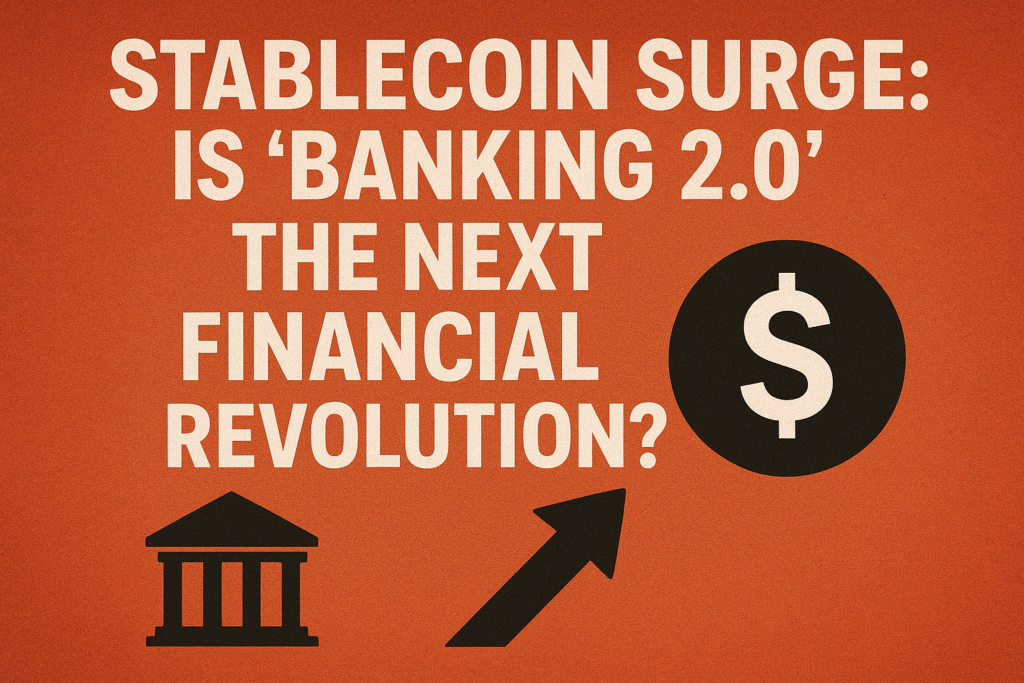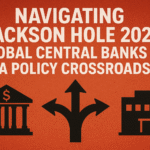Witnessing an unprecedented stablecoin surge, the financial world is at an inflection point. Explore how these digital assets are building the foundation for Banking 2.0, challenging traditional finance and reshaping global money movement.
The Quiet Revolution in Your Digital Wallet
Imagine sending $10 million across the globe. Not to a bank account, but to a digital wallet. Now imagine that transaction settling in under five seconds, costing you less than a dollar, and being transparently verifiable by anyone, anywhere, at any time. This isn’t a futuristic fantasy; it’s the reality being built today on the back of a stablecoin surge.
While the prices of Bitcoin and Ethereum capture headlines with their volatility, a quieter, more profound revolution is unfolding in the cryptocurrency ecosystem. Stablecoins—digital assets pegged to stable reserves like the US dollar—are experiencing explosive growth, not as speculative instruments, but as functional, powerful tools for value exchange. Their rise is not just a trend; it’s the foundational layer for a new financial paradigm often called Banking 2.0—a system that is decentralized, global, programmable, and accessible 24/7.
This article delves deep into this phenomenon. We will explore the drivers behind the stablecoin surge, demystify how they work, analyze the fierce regulatory battle brewing around them, and ultimately answer the critical question: Are stablecoins merely a useful payments tool, or are they the engine for the most significant financial revolution since the invention of double-entry bookkeeping?
Chapter 1: Beyond the Hype – What Are Stablecoins and Why Do They Matter?
Before understanding the surge, we must understand the asset.
The Core Concept:
A stablecoin is a type of cryptocurrency designed to minimize price volatility. Unlike Bitcoin, whose value is determined by market sentiment, most stablecoins are pegged 1:1 to a fiat currency, most commonly the US Dollar. For every $1 USD Coin (USDC) in circulation, there is (theoretically) one real US dollar held in a reserve bank account.
The “Why”: Solving Crypto’s Biggest Problem
Cryptocurrency’s inherent volatility is both its allure and its Achilles’ heel for everyday use. You wouldn’t want to be paid a salary in an asset that could lose 15% of its value overnight, nor would a merchant want to accept it for payment. Stablecoins solve this by providing the best of both worlds:
- The Stability of Fiat: The predictable value of traditional government-issued currency.
- The Power of Crypto: The borderlessness, speed, transparency, and programmability of blockchain technology.
This combination is the catalyst for the entire stablecoin surge. It creates a digital dollar that can travel on the internet’s native rails.
Chapter 2: Anatomy of the Surge – Key Drivers Fueling Adoption
The growth of stablecoins isn’t happening in a vacuum. It’s being driven by powerful technological, economic, and geopolitical forces.
1. The DeFi (Decentralized Finance) Engine:
The first and most powerful use case for stablecoins is within the world of DeFi. Platforms like Aave, Uniswap, and Compound use stablecoins as their primary medium of exchange and store of value. Users can:
- Lend their USDC to earn yield, often significantly higher than traditional savings accounts.
- Borrow against their crypto assets using stablecoins without needing a credit check.
- Trade and provide liquidity in a stable denomination.
DeFi provided the initial, powerful utility that kicked off the stablecoin surge, creating massive, organic demand.
2. The Institutional On-Ramp:
Major financial institutions, corporations, and asset managers are no longer watching from the sidelines. They are using stablecoins for:
- Cross-Border Payments and Settlements: A multinational corporation can use stablecoins to pay an international supplier, settling in minutes for a negligible fee instead of waiting days through the correspondent banking network and paying hefty wire transfer and FX conversion fees.
- Treasury Management: Companies like MicroStrategy hold portions of their treasury in stablecoins to earn yield in DeFi protocols, a modern version of cash management.
- 24/7 Markets: Traditional markets are closed nights and weekends. The crypto market never sleeps. Stablecoins allow institutions to move in and out of positions and manage risk around the clock.
3. The Remittance Revolution:
For migrant workers sending money back to their families, traditional services like Western Union and MoneyGram can charge fees of 5-10%. Stablecoins enable near-instant transfers for a fraction of the cost, directly to a family member’s smartphone, unlocking billions in value for the global poor.
4. Hedging Against Local Inflation:
In countries suffering from hyperinflation or capital controls (e.g., Argentina, Venezuela, Nigeria), stablecoins like USDT and USDC have become a digital lifeline. Citizens can convert their volatile local currency into a stable digital dollar to preserve their savings, a practice known as “crypto-dollarization.”
5. The Technical Infrastructure Maturation:
The development of faster, cheaper blockchains (like Solana, Avalanche, and Polygon) alongside Ethereum has made transacting with stablecoins feasible for micro-payments and everyday use, further accelerating adoption.
Chapter 3: The Contenders – A Breakdown of the Major Stablecoin Models
Not all stablecoins are created equal. Their design and underlying mechanics are a critical differentiator and a central point of regulatory scrutiny.
1. Fiat-Collateralized Stablecoins (The Giants)
- How they work: These are backed 1:1 by cash and cash-equivalent reserves (like short-term US Treasury bills) held with regulated banks. Regular attestations or full audits verify the backing.
- Examples:
- Tether (USDT): The largest and most controversial. Historically criticized for a lack of transparency, though it has recently improved its reporting.
- USD Coin (USDC): Managed by a consortium called Centre (founded by Circle and Coinbase). Praised for its transparency and compliance-first approach.
- Binance USD (BUSD): Issued in partnership with Paxos. (Note: The SEC’s action against Paxos in 2023 demonstrates the regulatory risks).
- Pros: Simple model, high stability if properly audited.
- Cons: Centralized, reliant on trust in the issuer and the banking system. Subject to regulatory seizure.
2. Crypto-Collateralized Stablecoins (The Decentralized Purists)
- How they work: Backed by a surplus of other cryptocurrencies (e.g., ETH) locked in smart contracts. They are over-collateralized to absorb price swings in the backing assets.
- Example: DAI. The flagship of this category, governed by a decentralized autonomous organization (DAO) called MakerDAO.
- Pros: Highly decentralized, censorship-resistant, transparent on the blockchain.
- Cons: Complex, can be vulnerable to death spirals during black swan market crashes if the collateral plummets too quickly.
3. Algorithmic Stablecoins (The “Holy Grail” That Failed)
- How they work: Not backed by tangible collateral but controlled by algorithms and smart contracts designed to manipulate supply (minting and burning coins) to maintain the peg.
- Example: TerraUSD (UST). The catastrophic collapse of UST in May 2022, which wiped out over $40 billion in value, serves as a stark warning of the model’s fragility.
- Pros: Ideally, fully decentralized and scalable.
- Cons: Extremely high risk. Proven to be vulnerable to bank runs and market sentiment shifts. The UST collapse set back the entire sector and drew intense regulatory ire.
Chapter 4: The Inevitable Clash – Regulation and The Road to Legitimacy
The stablecoin surge has placed it squarely in the crosshairs of regulators and central bankers worldwide. The debate is no longer if they will be regulated, but how.
The Key Regulatory Concerns:
- Systemic Risk: Could the failure of a major stablecoin issuer (like Tether) trigger a Lehman Brothers-like contagion event in both crypto and traditional markets?
- Monetary Policy and Sovereignty: What happens if a private, dollar-pegged stablecoin becomes the dominant medium of exchange in a foreign country, effectively dollarizing it without the US Federal Reserve’s consent?
- Investor and Consumer Protection: How are the reserves actually held? Are they truly available at all times to honor redemptions? The UST collapse is the prime example of what happens without guardrails.
- Illicit Finance: The perceived anonymity of crypto transactions, including stablecoins, raises concerns about their use for money laundering and terrorist financing (though blockchain’s transparency actually makes it a poor choice for these activities compared to cash).
The US Regulatory Landscape:
The key piece of pending legislation is the Lummis-Gillibrand Responsible Financial Innovation Act and other similar bills. Their goals are to:
- Define Stablecoins: Clearly categorize them as a distinct financial instrument.
- Establish Issuer Requirements: Mandate that all issuers be federally regulated banks or non-bank institutions with a special charter, subject to strict capital and liquidity requirements.
- Mandate Transparency: Require frequent, detailed public attestations and full audits of reserve holdings.
The outcome of this regulatory process will either cement the United States as the leader in the Banking 2.0 revolution or cede ground to more agile jurisdictions in Europe and Asia.
Chapter 5: Banking 2.0 – The Vision of a Programmable Financial System
This is the ultimate destination. Stablecoins are not the endgame; they are the plumbing for a radically upgraded financial system.
Banking 2.0 is characterized by:
- Programmable Money: Money that has logic built into it. A corporate treasury stablecoin could be programmed to only be spent on approved vendors. A welfare payment could be programmed to only be spent on food and rent, eliminating fraud.
- 24/7/365 Global Settlement: Financial markets that never close, with settlement finality in seconds, not days. This drastically reduces counterparty risk and frees up capital.
- Open and Composable Protocols (The “Money Legos”): DeFi protocols are like open-source APIs for finance. Developers can build, connect, and layer these applications to create entirely new financial products and services without asking for permission from a bank.
- Self-Custody and Financial Sovereignty: Individuals hold their own assets in their own digital wallets, eliminating the need to trust a third-party custodian (like a bank) and giving them ultimate control over their wealth.
In this vision, Banking 2.0 isn’t just a faster version of what we have. It’s a more open, inclusive, efficient, and innovative system built on a foundation of transparent, internet-native money.
Chapter 6: The Road Ahead – Challenges and Predictions
The path to Banking 2.0 is fraught with challenges.
- The Central Bank Digital Currency (CBDC) Wildcard: Over 100 countries are exploring their own digital currencies. Will they compete with or co-opt private stablecoins? A US digital dollar could fundamentally alter the landscape.
- Scalability and User Experience: For mass adoption, transactions need to be virtually free and instantaneous. The user experience of managing private keys and wallets must become as simple as using a mobile banking app.
- Interoperability: The financial system of the future cannot be fragmented across dozens of isolated blockchains. Seamless communication between networks is essential.
Predictions for the Next Phase of the Surge:
- The Great Consolidation: The number of viable stablecoins will shrink. Only those with impeccable regulatory compliance, transparency, and strong banking partnerships will survive.
- The Institutionalization of Yield: The high yields of DeFi’s “wild west” days will normalize, but regulated, institution-friendly platforms will emerge, offering better returns than traditional finance in a compliant manner.
- Stablecoins Become Boring Infrastructure: The focus will shift from price speculation to utility. Stablecoins will fade into the background, becoming as mundane and essential as the TCP/IP protocol that powers the internet—invisible but fundamental.
Conclusion: Revolution or Evolution?
The stablecoin surge is undeniable. It represents a massive, market-driven demand for a better form of money. The question of whether it leads to a full-blown financial revolution (Banking 2.0) or a more evolutionary upgrade to the existing system hinges on one factor: legitimacy.
That legitimacy will be won or lost in the halls of Congress, the boardrooms of central banks, and the court of public opinion. If the industry can successfully navigate the coming regulatory wave, build transparent and resilient models, and demonstrate clear benefits for everyday people, then the revolution is not just possible—it is inevitable. Stablecoins are the first, crucial step off the shores of the old financial world and into the vast, uncharted territory of a new one. The voyage has already begun.


